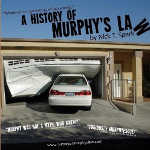 (Read Part I of this story first. You’ll find it here.)
(Read Part I of this story first. You’ll find it here.)
Now over 60 years old, Murphy’s Law is no longer the province of scientists and engineers. And that’s a shame.
Murphy’s Law has become the grown-up equivalent of “my dog ate my homework.” It’s an act of resignation. The world is (and here a shoulder shrug is appropriate) out of our hands.
But as Nick Spark, author of A History of Murphy’s Law explained in Part I of this story, Murphy’s Law was originally a statement of optimism.
“The team working with Northrop project manager George Nichols and researcher Dr. John Paul Stapp on the rocket sled experiments would study every aspect of the operation and all the components of the track. Everybody would throw out ideas about what things could go wrong. The idea was to head trouble off at the pass. So ‘if it can happen it will’ actually summed up an entire aspect of reliability engineering. And the engineers were delighted by it,” Spark recalled.
All that changed when Stapp used the aphorism at a press conference. (The details are somewhat sketchy. The press conference might have been held at Edwards Air Force Base in the early 1950s or at Holloman Air Force Base in New Mexico in 1955. The term first appeared in the New York Times on January 22, 1956.)
Once in the public domain why did Murphy’s Law take a pessimistic bent? Because Murphy’s Law apparently applies to itself. When there are multiple interpretations of a law the least optimistic one will prevail.
When Stapp discoverd the sobering statistic that more pilots died in car accidents every year than in airplane accidents, he became even more passionate about the need for proper safety harnesses—and not only at 50,000 feet.
As long as we’re analyzing history by aphorism, there’s another one we shouldn’t neglect: A good idea has many parents but a bad idea is an orphan. Murphy’s Law was a good idea so, naturally, the parents began lining up.
“Murphy tried to take the expression back and have it for himself,” Spark said, referring to comments Murphy made in a radio interview, a tape of which was provided to Spark by Murphy’s son, Robert.
In the interview, Murphy said that the first time he’d heard of Murphy’s Law was in a conversation he had with Stapp many years after that fateful day at Edwards. Murphy said that the name had made him lots of new friends.
“Nichols was not amused,” Spark said, referring to Murphy’s attempt to claim that he was the one who named the law. After all, Nichols did not intend to honor Murphy with the name but rather to rebuke him.
Murphy’s son, Robert, was not amused, either. “George Nichols is just an angry old man who regrets that the law was not named after him, nothing more. He is a self-tainted source,” he told Spark.
“No matter who who named the expression, the law was named in honor of Ed Murphy, that’s for sure,” Spark wrote in his book, “and Stapp was the person who popularized it. Without Stapp’s efforts at showing the world it was a universal truth, Murphy’s Law probably would have vanished into the ether.”
There are two things that get lost in the search for a definitive origin story. One, the environment at Edwards gave birth to Murphy’s Law as a law—as a formal statement of what were otherwise random observations over the years. Two, that same environment, a combination of research and engineering, indirectly saved millions of lives.
When Stapp discovered the sobering statistic that more pilots died in car accidents every year than in airplane accidents, he became even more passionate about the need for proper safety harnesses—and not only at 50,000 feet. In today’s terminology, he set out to disrupt the automobile business.
“What Stapp tried to force down Detroit’s throat was the need to put seatbelts in every car and simultaneously to give up a lot of the design aspects of the 1940s and 50s, those bright flashing knobs and metal dashboards, and replace them with things that were safer. It took a lot of work by Ralph Nader, and others, but it eventually happened,” Spark said.
And that’s where this story might end were it not for a 1911 book by by Nevil Maskelyne and David Devant called Our Magic.
On page 110, under the section heading “Presentation” the authors wrote, “It is an experience common to all men to find that, on any special occasion, such as the production of a magical effect for the first time in public, everything that can go wrong will go wrong.”
It serves as a reminder that the origin of Murphy’s Law is buried beneath a mixture of history, lore, and personal pride, and resolving that origin might be the historical equivalent of pulling a rabbit out of a hat.
Start your Sunday with a laugh. Read the Sunday Funnies, fresh humor from The Out Of My Mind Blog. Subscribe now and you'll never miss a post.
Nick Spark is a Los Angeles based writer and documentarian with a long standing passion for unconventional characters, including the oft-overlooked female heroine. His journey to discover the origins of Murphy’s Law began with research into the lives of Dr. John Paul Stapp and George Nichols, two of the men behind groundbreaking rocket sled experiments at Edwards Air Force Base in the late 1940s. The journey ended with the book (pictured here) A History of Murphy’s Law. An accomplished writer of non-fiction and history, Spark was the associate editor for Airpower magazines. He has also appeared on PBS’ History Detectives and NOVA, Japan’s NHK and National Public Radio. Spark earned his MFA at the U.S.C. School of Cinematic Arts, and has an undergraduate degree in Creative Writing from the University of Arizona. He also has the distinction of having won a student Emmy Award for his documentaries at both U.S.C. and U.A.
Mind Doodle…
While driving home after his meeting with Robert Murphy, Nick Spark’s car was hit from behind. The impact spun his car across the street and into the curb, leaving the car’s front and rear crumple zones barely recognizable.. Fortunately Spark was wearing his shoulder harness and seatbelt. He walked away uninjured.

Another great one Jay. The kicker is the real eyeopener.
Hi Nick…
Thanks, again, for your comments.
There’s no telling how far back Murphy’s Law—in concept if not in name—goes. Nick Spark makes a strong case for George Nichols as the one who changed the law into a Law. But, there are others willing to argue the point.
As I said in the piece, a good idea has many parents.
— jay